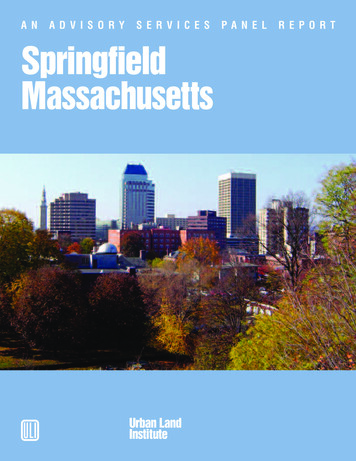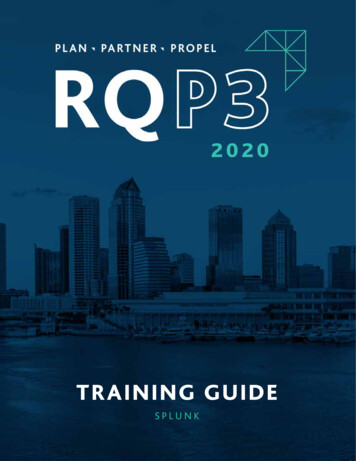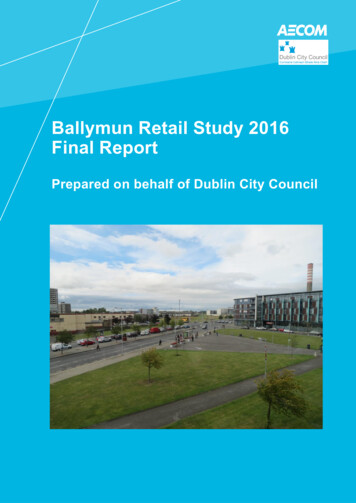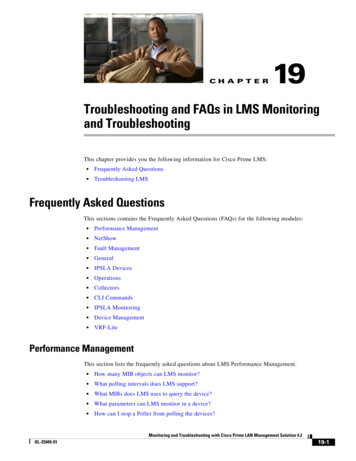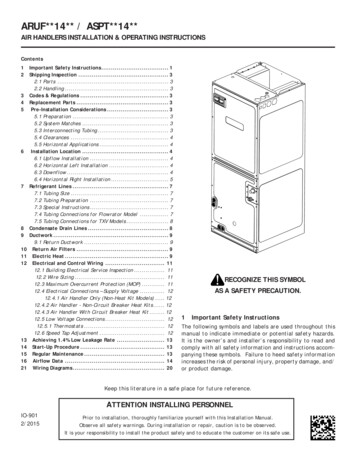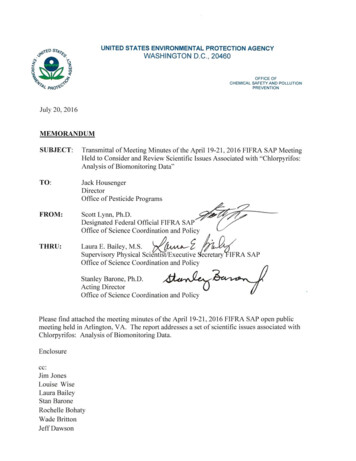
Transcription
FIFRA Scientific Advisory Panel Minutes No.2016-01A Set of Scientific Issues Being Considered by theEnvironmental Protection Agency RegardingChlorpyrifos: Analysis of Biomonitoring DataApril 19-21, 2016FIFRA Scientific Advisory Panel MeetingHeld at theEPA Conference CenterArlington, VA1
The Federal Insecticide, Fungicide, and Rodenticide Act (FIFRA) Scientific AdvisoryPanel (SAP) is a Federal advisory committee operating in accordance with the FederalAdvisory Committee Act and established under the provisions of FIFRA as amended bythe Food Quality Protection Act (FQPA) of 1996. The FIFRA SAP provides scientificadvice, information, and recommendations to the EPA Administrator on pesticides andpesticide-related issues regarding the impact of regulatory actions on health and theenvironment. The meeting minutes represent the views and recommendations of theFIFRA SAP and do not necessarily represent the views and policies of the EPA or ofother agencies in the Executive Branch of the Federal government. Mention of tradenames or commercial products does not constitute an endorsement or recommendationfor use. The meeting minutes do not create or confer legal rights or impose any legallybinding requirements on the EPA or any party.2
TABLE OF CONTENTSPANEL ROSTER . .6LIST OF ACRONYMS USED. .9INTRODUCTION .10PUBLIC COMMENTS .12OVERALL SUMMARY .18EXECUTIVE SUMMARY OF PANEL DISCUSSION ANDRECOMMENDATIONS.20DETAILED PANEL DELIBERATIONS AND RESPONSE TO CHARGE 31REFERENCES .733
NOTICEThe Federal Insecticide, Fungicide, and Rodenticide Act (FIFRA), Scientific AdvisoryPanel (SAP) is a Federal advisory committee operating in accordance with the FederalAdvisory Committee Act and established under the provisions of FIFRA as amended bythe Food Quality Protection Act (FQPA) of 1996. The FIFRA SAP provides advice,information, and recommendations to the Agency Administrator on pesticides andpesticide-related issues regarding the impact of regulatory actions on health and theenvironment. The Panel serves as the primary scientific peer review mechanism of theEnvironmental Protection Agency (EPA), Office of Pesticide Programs (OPP), and isstructured to provide balanced expert assessment of pesticide and pesticide-relatedmatters facing the Agency. FQPA Science Review Board members serve the FIFRA SAPon an ad hoc basis to assist in reviews conducted by the FIFRA SAP. The meetingminutes have been written as part of the activities of the FIFRA SAP. In preparing themeeting minutes, the FIFRA SAP carefully considered all information provided andpresented by EPA, as well as information presented in public comment.The meeting minutes of the April 19-21, 2016 FIFRA SAP meeting held to consider andreview scientific issues associated with “Chlorpyrifos: Analysis of Biomonitoring Data”were certified by James McManaman, Ph.D., FIFRA SAP Session Chair, and FredJenkins, Ph.D., FIFRA SAP Designated Federal Official, on July 15, 2016. The minuteswere prepared by Scott Lynn, Ph.D., FIFRA SAP Designated Federal Official andreviewed by Laura E. Bailey, M.S., FIFRA SAP Executive Secretary. The minutes arepublicly available on the SAP website (https://www.epa.gov/sap) under the heading of“Meetings” and in the public e-docket, Docket No. EPA-HQ-OPP-2016-0062, accessiblethrough the docket portal: http://www.regulations.gov. Further information about FIFRASAP reports and activities can be obtained from its website at https://www.epa.gov/sap.Interested persons are invited to contact Fred Jenkins, Ph.D., SAP Designated FederalOfficial, via e-mail at jenkins.fred@epa.gov.4
PANEL ROSTERFIFRA SAP Session ChairJames McManaman, Ph.D.Professor and ChiefSection of Basic Reproductive SciencesDepartment of Obstetrics and Gynecology, Physiology and BiophysicsUniversity of Colorado DenverAurora, CODesignated Federal OfficialFred Jenkins, Jr., Ph.D.U.S. Environmental Protection AgencyOffice of Science Coordination and PolicyFIFRA Scientific Advisory PanelEPA East Building, MC 7201M1200 Pennsylvania Avenue, NWWashington, DC 20460Phone: (202) 564-3327jenkins.fred@epa.govFIFRA Scientific Advisory Panel MembersMarion F. Ehrich, Ph.D.Co-director, Laboratory for Neurotoxicity StudiesProfessorPharmacology and ToxicologyDepartment of Biomedical Sciences & PathobiologyVirginia-Maryland College of Veterinary MedicineBlacksburg, VADavid A. Jett, Ph.D.Director, National Institute of Health Countermeasures Against Chemical ThreatsProgramNational Institute of Neurological Disorders and StrokeNational Institutes of HealthBethesda, MDSonya K. Sobrian, Ph.D.Associate ProfessorDepartment of PharmacologyHoward University College of MedicineWashington, DC6
FQPA Science Review Board MembersRussell Carr, Ph.D.Associate ProfessorCenter for Environmental Health SciencesMississippi State UniversityMississippi State, MSJeffrey Fisher, Ph.D.Research ToxicologistFood and Drug AdministrationNational Center for Toxicological ResearchWilliam Funk, Ph.D.Assistant ProfessorDepartment Preventive MedicineNorthwestern University Feinberg School of MedicineChicago, ILPanos Georgopoulos, Ph.D.ProfessorExposure Science DivisionEnvironmental and Occupational Health Sciences InstituteRobert Wood Johnson Medical SchoolRutgers, UniversityPiscataway, NJWilliam L. Hayton, Ph.D.Professor EmeritusDivision of Environment Health ScienceCollege of Pharmacy, School of Medicine and Public HealthOhio State UniversityColumbus, OHStella Koutros, Ph.D., M.P.H.InvestigatorOccupational & Environmental Epidemiology BranchDivision of Cancer Epidemiology and GeneticsNational Cancer InstituteNational Institute of HealthBethesda, MD7
Isaac Pessah, Ph.D.Professor of Pharmacology and ToxicologyDepartment of Molecular Biosciences School of Veterinary MedicineUniversity of CaliforniaDavis, CAWilliam Popendorf, Ph.D.Professor Emeritus of Industrial Hygiene at Utah State UniversityDepartment of BiologyUtah State UniversityLogan, UTDiane Rohlman, Ph.D.Associate ProfessorOccupational and Environmental HealthThe University of IowaIowa City, IASharon K. Sagiv, Ph.D., M.P.H.Assistant Adjunct Professor of EpidemiologyBerkeley School of Public HealthUniversity of CaliforniaBerkeley, CALisa M. Sweeney, Ph.D., DABT, CHMMSenior ScientistHenry M. Jackson Foundation for the Advancement of Military MedicineDetailed to the Naval Medical Research Unit DaytonDayton, OHAlvin V. Terry, Jr., Ph.D.Regents Professor and ChairDepartment of Pharmacology and ToxicologyMedical College of GeorgiaAssociate Vice President for Basic Science ResearchAugusta UniversityAugusta, GA8
LIST OF ACRONYMS holinesteraseAbsorption, distribution, metabolism, excretionAgricultural Handler Exposure Task ForceAdverse outcome pathwayBenchmark doseColumbia Center for Children’s Environmental HealthClinical Laboratory Improvement AmendmentsChlorpyrifosChlorpyrifos-oxonDow Agro SciencesEnvironmental Protection AgencyExposure Related Dose Estimating ModelFederal Insecticide Fungicide Rodenticide ActFood Quality Protection ActGood Laboratory PracticesHuman health risk assessmentIntegrated Risk Information SystemLevel of detectionMode of actionNon-detectNational Research CouncilOrganophosphatePhysiologically based pharmacokineticPesticide Data ProgramPesticide Handlers Exposure DatabasePharmacokineticPoint of departureRed blood cellReference doseScience Advisory Panel3,5,6,-trichloro-2-pyridinolTime weighted averageUnited StatesWorking memory index9
INTRODUCTIONOn April 19-21, 2016 the US EPA Federal Insecticide, Fungicide, and Rodenticide ActScientific Advisory Panel (FIFRA SAP) met in an open public meeting in Arlington, VAto consider and review scientific issues associated with “Chlorpyrifos: Analysis ofBiomonitoring Data”. Chlorpyrifos (0,0-diethyl-0-3,5,6-trichloro -2-pyridylphosphorothioate) is a broad-spectrum, chlorinated organophosphate (OP) insecticide,acaricide, and miticide used to control a variety of insects. Currently, registered usesinclude food and feed crops, golf course turf, greenhouses, non-structural woodtreatments (such as utility poles and fence posts), ant bait stations, fire ant mounds, aUSDA quarantine use for containerized/potted ornamentals, and use as an adultmosquitocide. The Agency has taken a stepwise, objective and transparent approach inevaluating, interpreting, and characterizing the strengths and uncertainties associated withall of the available lines of scientific information related to the human health effects ofchlorpyrifos. Like other OPs, chlorpyrifos binds to and phosphorylates the enzymeacetylcholinesterase (AChE) in both the central (brain) and peripheral nervous systems.This can lead to accumulation of acetylcholine and, ultimately, at sufficiently high doses,to clinical signs of toxicity. In addition to the AChE inhibiting potential of chlorpyrifos,there is a growing body of literature with laboratory animals (rats and mice) indicatingthat gestational and/or early postnatal exposure to chlorpyrifos may cause persistenteffects into adulthood along with epidemiology studies which have evaluated prenatalchlorpyrifos exposure in mother-infant pairs and reported associations withneurodevelopment outcomes in infants and children. The Agency has followed up onprevious SAP recommendations and used a physiologically based pharmacokinetic(PBPK) model to further assess the epidemiological data and the Agency is nowsoliciting comment on changing the critical effect for quantitative risk assessment fromAChE inhibition to neurodevelopmental outcomes. Thereby the Agency would bechanging the Point of Departures (PoDs) from doses eliciting 10% red blood cell (RBC)AChE inhibition to adverse effects changes in neurodevelopment as measured byepidemiology studies conducted by Columbia Center for Children’s EnvironmentalHealth (CCCEH). The FIFRA SAP was convened to provide advice to the Agencyregarding the evaluation of biomonitoring chlorpyrifos data from epidemiology studies.US EPA presentations were provided during the FIFRA SAP meeting by the following(listed in order of presentation):Welcome and Opening Remarks – Jack Housenger, Director, Office of PesticidesPrograms (OPP), EPAChlorpyrifos: Background and Overview – Dana Vogel, Division Director, HealthEffects Division (HED), OPP, EPAChlorpyrifos: Overview of EPA Epidemiological Literature Review – ElizabethHolman, Dr.PH., HED, OPPInterpreting Biomarker Data in the CCCEH Cohort Using a Physiologically BasedPharmacokinetic (PBPK) Model – Cecilia Tan, Ph.D., HED, OPP10
Chlorpyrifos: Evaluation of CCCEH Blood Data and Predicted Exposures –Wade Britton, M.P.H., HED, OPP; Rochelle Bohaty, Ph.D., Environmental Fate andEffects Division (EFED), OPP; Danette Drew, HED, OPPPoint of Departure, Intra-species Extrapolation, the FQPA 10X Safety Factor, andCase Studies: Linking Exposure Assessment with PBPK Modeling to DerivePredicted Internal Doses – Anna Lowit, Ph.D., HED, OPP, EPA11
PUBLIC COMMENTSOral statements were provided by:1)On behalf of Dow Agrosciences:a.Daland R. Juberg, Ph.D., ATS, Global Leader, Human Health Assessment Regulatory Sciences, Dow AgroSciencesb.Jeffrey H. Driver, Dr.P.H., D.A.B.T., M.T., C.L.S., Principal & SeniorToxicologist, risksciences.net, LLCc.Carol J. Burns, MPH, Ph.D., FACE, Senior Dow Epidemiologist, The DowChemical Companyd.William Banner, M.D., Ph.D., FAAP, FAACT, FACMT, FCCM, PediatricMedicine and Pediatric Toxicology; Medical Director of the Oklahoma PoisonControl Center, Attending Physician, Pediatric ICU, Baptist Integris MedicalCenter, Oklahoma City, Oklahoma2) Wendy Hessler, Private citizen3) Scott Schertz, Schertz Aerial Service, Inc.4) CropLife America5) Ellen Webb, MPH, Center for Environmental Health6) Scott Slaughter, The Center for Regulatory Effectiveness7) Elliot Gordon, Ph.D., DABT, Elliot Gordon Consulting, LLC8) Sarada Tangirala, National Campaigns Manager, Women's Voices for the Earth9) Jennifer Sass, Ph.D., Senior Scientist, Natural Resources Defense Council10) Exponent11) Virginia Ruiz, Farmworker Justice12) Sheryl H. Kunickis, Ph.D., Director, US Department of Agriculture Office of PestManagement Policy13) Paul Hinderliter, Ph.D., Senior Scientist, Syngenta Crop Protection, LLC and EllenT. Chang, Sc.D., Exponent, Inc.14) Lynne Parsons Heilbrun, MPH, Faculty Specialist, Department of Family andCommunity Medicine, UT School of Medicine, UT Health Science Center at SanAntonioWritten public comments were provided by:1)On behalf of themselves:a.Dr. Michael Goodman, Emory Universityb.Dr. Judy LaKind, LaKind Associatesc.Dr. Michael Dourson, University of Cincinnatid.Dr. Jennifer Seed, Independent Consultant2) On behalf of themselves:a.Jennifer Sass, Ph.D., Senior Scientist, Natural Resources Defense Councilb.Robin M. Whyatt, DrPH, Professor Emeritus, Columbia Universityc.Laura Anderko, Ph.D., RN, Professor, Georgetown Universityd.Howard F. Andrews, Ph.D., Associate, Columbia University12
cc.dd.ee.ff.gg.hh.ii.jj.kk.Thomas A. Arcury, Ph.D., Professor, Wake Forest School of MedicineDavid Bellinger, MSc, Ph.D., Professor, Harvard UniversityCharles Benbrook, Ph. D., Benbrook Consulting ServicesDeborah Bennett, Ph.D., Associate Professor, UC DavisRuth Berlin, LCSW-C, Executive Director, Maryland Pesticide EducationNetworkPaul Brandt-Rauf, DrPH, M.D., ScD, Professor Emeritus, ColumbiaUniversitySusan Buchanan, M.D., MPH, University of Illinois at Chicago School ofPublic HealthSheila Bushkin-Bedient, M.D., MPH, Waterford, NYJaehyun Byun, M.D., Santa Paula Medical ClinicDavid O. Carpenter, M.D., Director, University at AlbanyLynn Carroll, Ph.D. Senior Scientist, The Endocrine Disruption ExchangeLarysa Dyrszka, M.D.Stephanie M. Engel, Ph.D., Associate Professor University of North Carolinaat Chapel HillPam Factor-Litvak, Ph.D., Professor, Columbia UniversityLinda Forst, M.D., MPH, Professor, University of Illinois at ChicagoRobert M. Gould, M.D., Associate Adjunct Professor, UCSF School ofMedicineJoseph H. Graziano, Ph.D., Professor, Columbia UniversityAlycia Halladay, Ph.D., Adjunct, Rutgers UniversityRuss Hauser M.D., ScD, MPH, Professor, Harvard Medical SchoolIrva Hertz-Picciotto, Ph.D., Professor, University of California Davis Schoolof MedicineJane Hoppin, ScD, Associate Professor, NC State UniversityKatie Huffling, RN, M.S., CNM Director of Programs Alliance of Nurses forHealthy EnvironmentsRichard J Jackson M.D., MPH, Professor, University of CaliforniaMargaret R. Karagas, Ph.D., Professor & Chair, Dartmouth UniversityMatthew Keifer, M.D., MPHJonathan Kirsch, M.D., Assistant Professor, University of MinnesotaCandace Kugel, FNP, CNM, M.S., Clinical Specialist, Migrant CliniciansNetworkCarol F. Kwiatkowski, Ph.D., Executive Director, The Endocrine DisruptionExchangePhilip J. Landrigan, M.D., MSc, FAAP, Professor, Icahn School of Medicineat Mount SinaiBruce P. Lanphear, M.D., MPH, Professor, Simon Fraser UniversityEdward D. Levin, Ph.D., Professor, Duke University Medical CenterAmy K. Liebman, MPA, MA, Director, Environmental and OccupationalHealth Migrant CliniciansChensheng (Alex) Lu, Ph.D., Associate Professor, Harvard T.H. Chan Schoolof Public Health13
ll.Emily Marquez, Ph.D., Staff Scientist, Pesticide Action Network NorthAmericamm. Linda McCauley, Ph.D., RN, Dean and Professor, Emory Universitynn.Rob McConnell, M.D., Professor, University of Southern Californiaoo.Kristine McVea, M.D., MPHpp.Mark Miller, M.D., MPH, Assistant Clinical Professor, University ofCaliforniaqq.Scott Morris, M.D., MPH, FACOEM, American College of Occupational andEnvironmental Medicinerr.Carlos O'Bryan, M.D., FAAFP, Las Islas Family Medical Groupss.Peter Orris, M.D., MPH, Professor, University of Illinois Hospital and HealthSciences Systemtt.Nancie Payne, President, Learning Disabilities Association of Americauu.Devon Payne-Sturges, DrPH, Assistant Professor, University of MarylandSchool of Public Healthvv.Frederica Perera, DrPH. Ph.D., Professor, Columbia Universityww. Sara A. Quandt, Ph.D., Professor, Wake Forest School of Medicinexx.Virginia A. Rauh, ScD, Professor, Columbia Universityyy.Elena Rios, M.D., MSPH President and CEO, National Hispanic MedicalAssociationzz.James R Roberts, M.D., MPH, Professor, Medical University of SouthCarolinaaaa. Ted Schettler, M.D., MPH, Science Director, Science and EnvironmentalHealth Networkbbb. Theodore Slotkin, Ph.D., Professor, Duke University Medical Centerccc. Rosemary Sokas, M.D., MOH, Professor, Georgetown University School ofNursing and Health Studiesddd. Lisa Solinas, M.D., Medical Director, Santa Paula West Medical Group &Pediatricseee. Shanna H. Swan, Ph.D., Professor, Icahn School of Medicine at Mount Sinaifff.Claudia Thomas, M.D.ggg. Gayle Thomas, M.D., Medical Director, NC Farmworker Health Programhhh. Ho Luong Tran, M.D., MPH, President and CEO, National Council of AsianPacific Islander Physiciansiii.David Wallinga, M.D., MPA, Senior Health Officer, Natural ResourcesDefense Counciljjj.Harry Wang, M.D., Vice-President, Physicians for SocialResponsibility/Sacramento Clinicalkkk. Minako Watabe, M.D., Ventura County Medical Centerlll.Virginia M Weaver M.D., MPH, Associate Professor, Johns HopkinsUniversity Blomberg School of Public Healthmmm. David H Wegman, M.D., MSc, Professor Emeritus, UMass Lowellnnn. Mary Wolff, Ph.D., Professor, Icahn School of Medicine at Mount Sinaiooo. Tracey J. Woodruff, Ph.D., MPH, Professor and Director, UCSF Program onReproductive Health and the Environmentppp. Sandy Young, FNP, Las Islas Family Medical Group14
qqq. Ed Zuroweste, M.D., Assistant Professor, Johns Hopkins School of Medicine3) Anonymous4) On behalf of CropLife America:a.Janet E. Collins, Ph.D., R.D., Senior Vice President Science and RegulatoryAffairs, CropLife America5) Sheryl H. Kunickis, Ph.D., Director, US Department of Agriculture Office of PestManagement Policy6) On behalf of Dow Agrosciences:a.George R. Oliver, Ph.D., Regulatory Manager, Dow AgroSciences LLC7) On behalf of Syngenta Crop Protection, LCC:a.Jerry Wells, Ph.D., Regulatory Herbicide Team Lead, Syngenta CropProtection, LLCb.Charles B. Breckenridge, Ph.D., Senior Research and Technology Fellow,Syngenta Crop Protection, LLCc.Anthony R. Scialli, M.D., Scialli Consulting, LLCd.Ellen T. Chang, Sc.D., Exponent, Inc.e.Paul Hinderliter, Ph.D., Senior Scientist, Syngenta Crop Protection, LLC8) Cindy Baker Smith, Senior Vice President and Director of Global RegulatoryAffairs, AMVAC Chemical Corporation9) Rita Schoeny, Ph.D.10) On behalf of themselves:a.Agricultural Retailers Associationb.Almond Hullers & Processors Associationc.American Farm Bureau Federationd.AmericanHorte.American Soybean Associationf.American Society of Sugar Beet Technologistsg.American Sugarbeet Growers Associationh.Beet Sugar Development Foundationi.California Citrus Mutualj.California Citrus Quality Councilk.California Cotton Ginners Associationl.California Cotton Growers Associationm.California Date Commissionn.California Dried Plum Boardo.California Fig Advisory Boardp.California Fresh Fruit Associationq.California Specialty Crops Councilr.California Strawberry Commissions.California Walnut Commissiont.Cranberry Instituteu.CropLife Americav.Florida Fruit & Vegetable Association15
w.Golf Course Superintendents Association of Americax.National Agricultural Aviation Associationy.National Association of State Departments of Agriculturez.National Association of Wheat Growersaa.National Corn Growers Associationbb.National Cotton Councilcc.National Council of Farmer Cooperativesdd.National Pest Management Associationee.National Potato Councilff.National Sorghum Producersgg.North American Blueberry Councilhh.Northwest Horticultural Councilii.Sunsweet Growers Inc.jj.United Fresh Produce Associationkk.U.S. Apple Associationll.Valley Fig Growersmm. Washington Friends of Farms & Forestsnn.Washington State Potato Commissionoo.Western Agricultural Processors Associationpp.Western Growers Association11) On behalf of Syngenta Crop Protection, LCC:a.Ellen T. Chang, Sc.D., Senior Managing Scientist, Exponent, Inc.b.Dr. Paul Hinderliter, Senior Scientist, Syngenta Crop Protection, LLC12) On behalf of Dow Agrosciences:a.George R. Oliver, Ph.D., Regulatory Manager, Dow AgroSciences LLCb.Carol J. Burns, MPH, Ph.D., FACE, Senior Dow Epidemiologist, The DowChemical Company13) Lynne Parsons Heilbrun, MPH, Faculty Specialist, Department of Family andCommunity Medicine, UT School of Medicine, UT Health Science Center at SanAntonio14) On behalf of themselves:a.Emily Marquez, Ph.D., Staff Scientist, Pesticide Action Networkb.Ellen Webb, Healthy Energy Sciences & Advocacy Manager, Center forEnvironmental Healthc.Lorraine Coke, Policy and Project Manager, Coke Farm, Inc.d.Minako Watabe, OB/GYN, Ventura County Hospitale.Sarada Tangirala, National Campaigns Manager, Women’s Voices for theEarthf.Wendy Hessler, Science Communicator15) On behalf of themselves:a.Natural Resources Defense Councilb.Farmworker Justicec.Earthjusticed.Pesticide Action Network16
e.f.g.United Farm WorkersCalifornia Rural Legal Assistance FoundationPineros y Campesinos Unidos del Noroeste16) William Banner, M.D., Ph.D., FAAP, FAACT, FACMT, FCCM, Medical Director,Oklahoma Poison Control Center17) Minako Watabe, M.D., OB/GYN, Ventura County Hospital18) Dale Hattis, Clark University19) On behalf of Dow Agrosciences:a.Carol J. Burns, MPH, Ph.D., FACE, Senior Dow Epidemiologist, The DowChemical Company20) On behalf of Dow Agrosciences:a.Daland R. Juberg, Ph.D., ATS, Global Leader, Human Health Assessment Regulatory Sciences, Dow AgroSciencesb.Jeffrey H. Driver, Dr.P.H., D.A.B.T., M.T., C.L.S., Principal & SeniorToxicologist, risksciences.net, LLCc.Carol J. Burns, MPH, Ph.D., FACE, Senior Dow Epidemiologist, The DowChemical Companyd.William Banner, M.D., Ph.D., FAAP, FAACT, FACMT, FCCM, PediatricMedicine and Pediatric Toxicology; Medical Director of the Oklahoma PoisonControl Center, Attending Physician, Pediatric ICU, Baptist Integris MedicalCenter, Oklahoma City, Oklahoma21) On behalf of Dow Agrosciences:a.Julie E. Goodmanb.Christine Loftus, Gradient22) On behalf of The Center for Regulatory Effectiveness:a.Scott Slaughter, The Center for Regulatory Effectiveness23) Jeffrey Driver, risksciences.net, LLC24) On Behalf of CropLife America:a.Sarah E. Starks, Ph.D.b.Amechi Chuwudebe, Ph.D.25) Anonymous26) Dow AgroSciences, LLC27) Elliot Gordon, Ph.D., DABT, Elliot Gordon Consulting, LLC28) On Behalf of CropLife America:a.Tamika D. Sims, Ph.D., Director, Human Health Policy, CropLife America17
OVERALL SUMMARYThe FIFRA SAP was convened to provide advice to the Agency regarding theevaluation of biomonitoring chlorpyrifos data from epidemiology studies. The Panelsupports the use of measured maternal chlorpyrifos blood concentrations as a surrogatefor fetal exposure presuming chlorpyrifos readily crosses the placenta. However, thereare several methodological issues/uncertainties in the analyses suggesting that a 1:1 ratioof concentrations between mother’s blood and the newborn cord blood may be in error.Plasma is not the same as whole blood, but plasma was used for measurements and thephysiologically based pharmacokinetic (PBPK) models are built using whole blood.Most of the Panel was not in favor of using cord blood chlorpyrifos levels as a surrogatefor exposure of infants ( 1 year old). The use of the cord blood measurements to informan ex-utero infant’s exposure-response to chlorpyrifos raised many concerns, resulting ingreatly diminished support. Most of the Panel was not in favor of using the chlorpyrifosconcentration in cord blood at birth as a surrogate for the chlorpyrifos bloodconcentration during the 1- to 2-year age period.The Panel agrees with the Agency that there are complex unknown variables thatare recognized as uncertainties. Because many uncertainties cannot be clarified, themajority of the Panel does not have confidence that the Columbia Center for Children’sEnvironmental Health (CCCEH) cord blood data on chlorpyrifos concentrations canaccurately be used in quantitative risk assessment to determine a Point of Departure(PoD). A major source of uncertainty for the Panel was the lack of verification andreplication of the analytical chemistry results that reported very low levels of chlorpyrifos(pg/g). Imputing quantitative values when the concentration of analyte falls below thelevel of detection (LOD) was a particular concern, especially given that a large fractionof cord blood samples included in the analyses presented with levels below LOD.Multiple Panel members noted that PBPK modeling is a valuable tool to interpretthe biomonitoring data in circumstances where multiple routes of exposure occur andwhen based on best available information as inputs. Concern was raised by at least twoPanel members about parameter use, model assumptions, and an absence of sensitivityanalysis. Panel members were not in consensus as to the level of agreement between theAgency’s exposure characterization of the CCCEH and the blood measurements from thestudy. Overall, the Panel found that the general scenarios provided for PBPK modelingare reasonable (drinking water, food, residential). The Panel found several sources ofuncertainty in the estimates of internal blood levels and their relationship to the CCCEHcohort results. Some Panel members thought the quality of the CCCEH data is hard toassess when raw analytical data have not been made available, and the study has not beenreproduced.The Panel agrees that both epidemiology and toxicology studies suggest there isevidence for adverse health outcomes associated with chlorpyrifos exposures belowlevels that result in 10% red blood cell (RBC) acetylcholinesterase (AChE) inhibition(i.e., toxicity at lower doses). However, the Panel agrees with the Agency that applyingadditional safety factors to the AChE PoDs to account for a possible noncholinergicmode of action (MOA) would be problematic because of challenges in justifying anyparticular value for such an adjustment. The majority of the Panel did not agree with theAgency’s use of the results from a single longitudinal study to make a decision based on18
the use of cord blood measures of chlorpyrifos as a PoD for risk assessment. The Panelwas not in favor of using the lower limit of the top tertile for deriving a PoD forextrapolating risk to chlorpyrifos. The Panel was not satisfied with the arbitrary cut-offfor the tertile distributions, the high-low dichotomization in the analysis, and thedifferences in interpretation based on the high-low dichotomization compared to thatobtained when grouped into a non-detect (ND), low, mid, and high groups. The Panelconsiders the Agency's decision to use Benchmark Dose (BMD) derived from linearregression for deficits in working memory as a valid plan if the Agency were to decide touse cord blood chlorpyrifos to determine PoD. The majority of the Panel stated that usingcord blood chlorpyrifos concentrations for derivation of the PoD could not be justified byany sound scientific evaluation. The Panel was conflicted with respect to the importanceof a 2% change in working memory.Overall the Panel found that the use of the 10X intra-species extrapolation factoris appropriate, however there are other areas of uncertainty that should be considered.Uncertainty is mostly attributed to the inability of single measures of chlorpyrifosconcentration in blood to provide information regarding source, frequency, duration andmagnitude of exposure, and how these exposures are linked to specific outcomesmeasured in the CCCEH study participants. Overall, the Panel concurs with theAgency’s conclusion that the lack of postnatal exposure assessment in the CCCEH studyis a source of uncertainty. While the prenatal period is likely the most sensitive tochlorpyrifos exposure, the brain continues rapid development postnatally. The majority ofPanel members stated that the moderate sample size of the CCCEH is not a source ofuncertainty, however some Panel members did identify uncertainties. Some Panelmembers stated that the sample size may have limited the CCCEH study’s ability toexamine the association of chlorpyrifos blood concentration on neurodevelopment inmore vulnerable populations, such as racial minorities or lower socioeconomic statusindividuals.The Panel decided the model was appropriately implemented with regard to doselinearity and the duration of the simulations. The simulated blood concentrations were inthe pg/mL range, so saturation of metabolism was not a concern. Other model parametervalues such as tissue / blood partition coefficients and blood flows to tissues wereunlikely to be affected by the relatively low chlorpyrifos blood concentration, so theassumption that internal concentration would be linearly related to external dose rate wasappropriate. Simulations of the various exposure scenarios were run well into the steadystate time frame. The inputs of chlorpyrifos to the PBPK model from drinking water,food, and worker – handler exposure appeared to be appropriate and defensible. Theinputs were well informed by a considerable amount of data relating to expected drinkingwater concentrations, and dietary con
Panel (SAP) is a Federal advisory committee operating in accordance with the Federal . Interested persons are invited to contact Fred Jenkins, Ph.D., SAP Designated Federal Official, via e-mail at jenkins.fred@epa.gov. 6 . PANEL ROSTER. . Control Center, Attending Physician, Pediatric ICU, Baptist Integris Medical Center, Oklahoma City .


